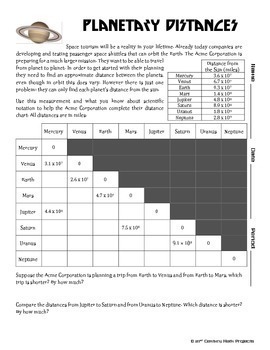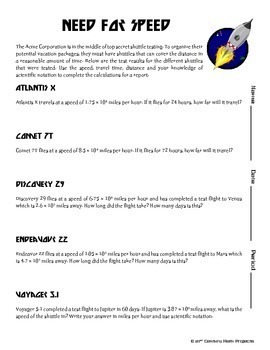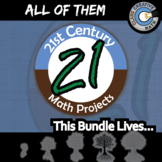Intergalactic Tourism -- Scientific Notation - 21st Century Math Project
- Zip
- Google Apps™

Also included in
- The project is the core of what I have built my classroom around. Scaffolding learners to real world projects. This bundle includes the 105+ math projects I have written. This is over 2,700 pages of content.21st Century Math Projects each scaffold through an authentic context and math skill buildingPrice $395.00Original Price $564.00Save $169.00
- This is a selection of my Scientific Notation resources all in a money saving Essential Bundle! You save significant money and time versus purchasing these separately!Essential Bundles are designed to give you everything you need to rock your unit. Warmups, Notes, Activities, Games, Exit Tickets, anPrice $25.00Original Price $60.00Save $35.00
- 12 of my best selling projects/units all in an organized money saving bundle! These engaging, student/teacher approved math projects that provide rigor, relevance, and cross-curricular content altogether. I have each of these projects advertised separately these projects are $70, so this is over 30%Price $45.00Original Price $70.00Save $25.00
Description
Space tourism is only a matter of time. Prepare your students of intergalactic travel with a little bit of scientific notation practice mixed in :-)
In this 21st Century Math Project, you will be given a mapping to the Content Standards, an outline for how to implement the project, 3 different assignments for students to use, and an answer key. ***THIS PRODUCT HAS BEEN UPDATED WITH A GOOGLE SLIDES INTERACTIVE VERSION INCLUDED. REDOWNLOAD IF YOU HAVE IT ALREADY***
Download the preview to see pretty much everything!
-- In “Planetary Distances” students use subtraction of scientific notation to find the distance between planets using their distance from the sun.
-- In “Need for Speed” students will practice using scientific notation in distance, rate and time problems. This will require multiplying and dividing numbers in scientific notation.
-- In “My Space Vacation" students will tie all of the skills together. Students will need to multiply, divide, add and subtract numbers in scientific notation. Students are given travel information for four different alien races and will use the data in an attempt to learn more about the aliens.
You may be interested in the following discounted bundles. SAVE $$$!
•21st Century Math Projects -- All the Projects
Need an Entire Curriculum?
•21st Century Pre-Algebra –- the Entire Curriculum
•21st Century Algebra –- the Entire Curriculum
For more tips, tricks and ideas check out the Clark Creative Education Blog
And join our community where I post ideas, anecdotes, elaborations & every once in a while I pass out TPT gift cards! And jokes! I do jokes too!








